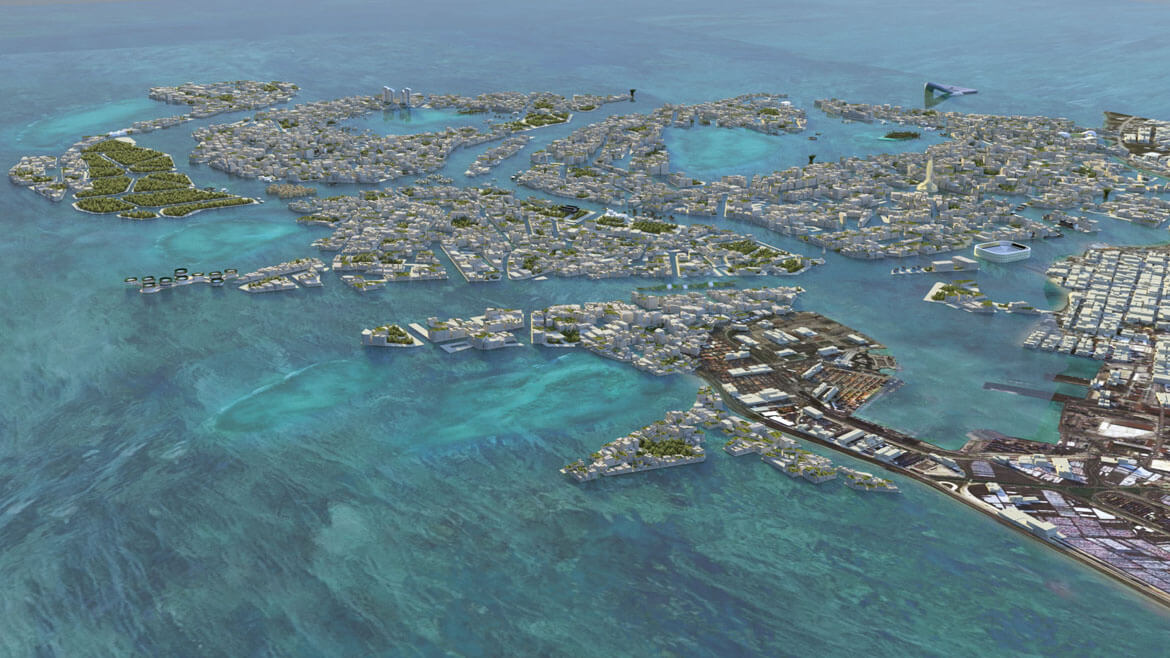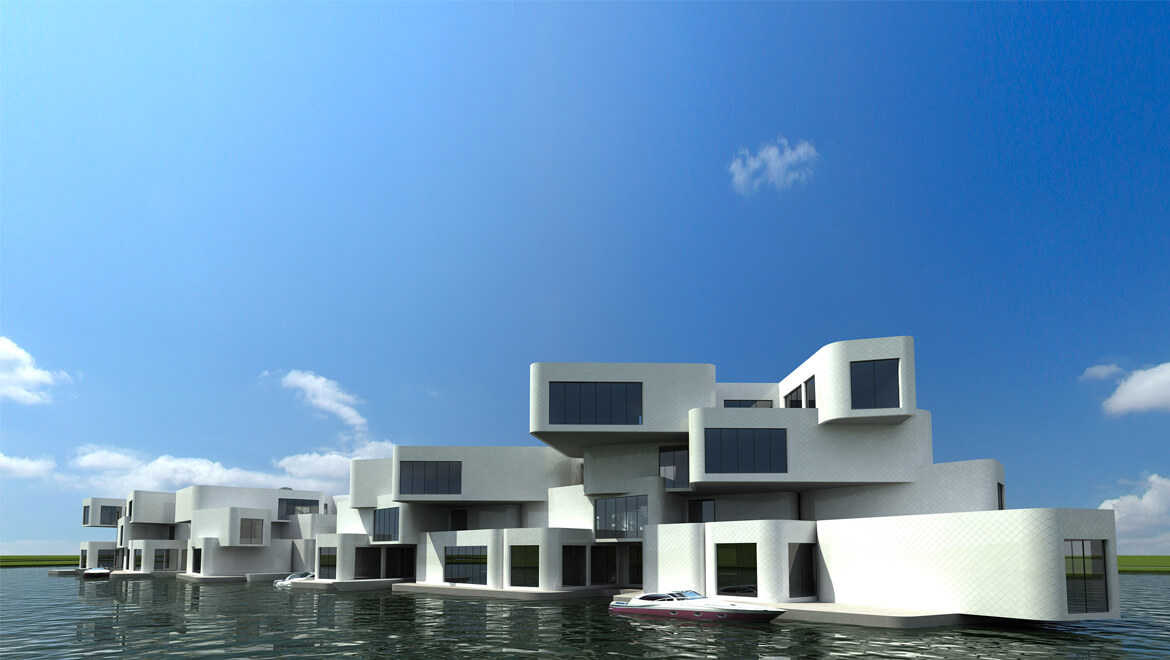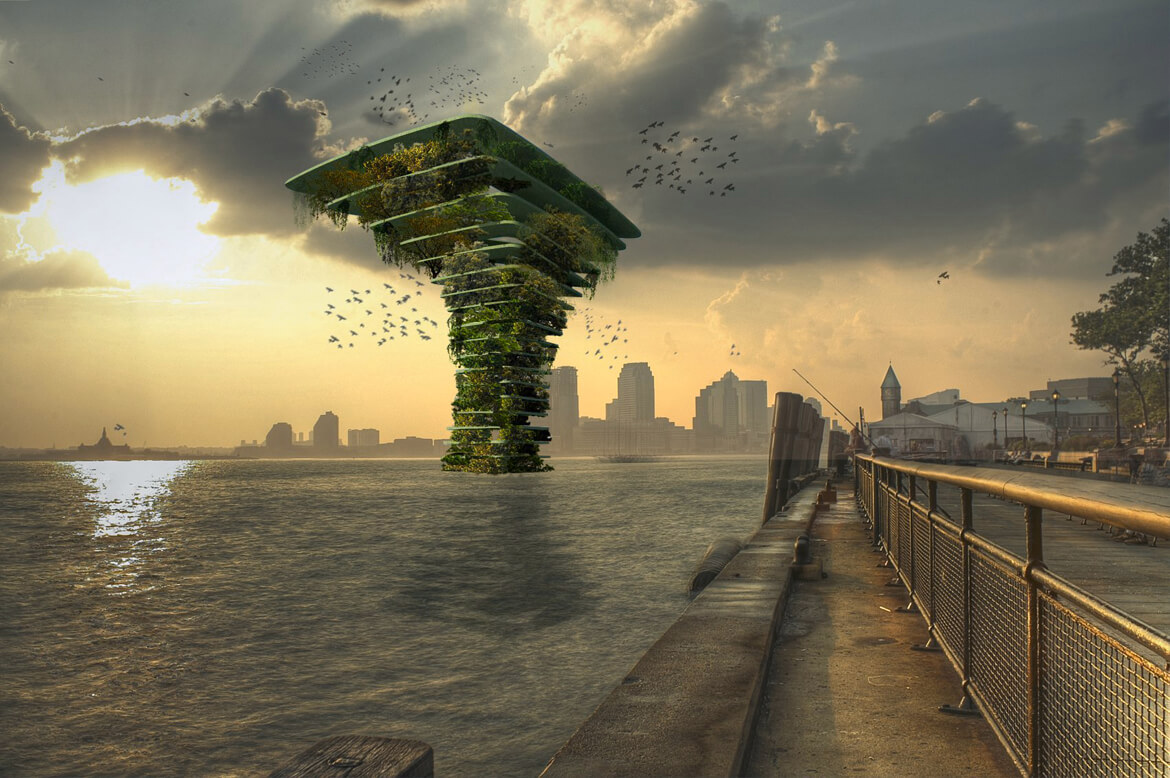
Rise of the Blue City
By Gif Im Focus
As an architect, you have designed floating structures and urban plans in relation to water. The Dutch have always fought against the water, but you are saying that we should rather live with the water. Your vision is that water will play a bigger role in the future of cities. So my first question is:
As an architect, you have designed floating structures and urban plans in relation to water. The Dutch have always fought against the water, but you are saying that we should rather live with the water. Your vision is that water will play a bigger role in the future of cities. So my first question is:
What is a city for you?
There are different ways of looking at a city. A sociologist will probably say a city is characterised by the way its citizens interact, and an ecologist would probably see the city as an environment with different habitats and species. As an architect, I see cities as a mix of three elements. Firstly, the specifics of the natural location, the DNA of the city. Secondly, the built-up environment, made up of buildings and infrastructure, i. e. the city’s hardware. And thirdly, the protocols,
which are a combination of the rules, regulations, traditions and culture of the community, which determine how the hardware in a city can be used.
All cities are not equal, and these three elements create a kind of balance or structure that determines the profile of a city. I think that the role of an architect should be to analyse city profiles, see their shortcomings and come up with new solutions of how to upgrade the performance of the city. This performance should
be measured in terms of how liveable the city is.
Can we not just grow further with the same system?
Today it is hard to imagine a city without revolutionary innovations that have become part of our normal lives, such as cars, electricity and the internet, which have all changed the profile of cities and the way we live. The introduction of electricity, mobility, lifts etc. has been a game changer, altering the functionality and liveability of cities. Steve Jobs said
in 1997: “A lot of times, people don’t know what they want until you show it to them.” I think this also applies to urban innovation. We think that the concept of a city has reached its final stage, but we are just in a process of evolution. Urbanisation and climate change are having a great effect on the available space and put pressure on the capacity of urban functions in cities. Growing urban congestion, the rising cost of city housing and maintenance are only a few indicators of the difficulties static cities face in adapting to change. What I mean is that the demands of society change so fast that it is not possible for a city to respond immediately because of the nature of its static hardware. Its response time is too long.
How should we get ready for change?
Investments for the future must be made to keep cities running smoothly, but what if you do not know what tomorrow’s needs will be? Big investments in infrastructure can be useless tomorrow as technology changes the way we live or use space and facilities. The only way to resolve this dilemma is to start building for change. Charles Darwin said: “It is not the strongest or the most intelligent who will survive but those who can best manage change.” Cities are living organisms, so they should change and create the potential to react to change. For this, they need to find space to grow, shorten response times and make rules and regulations more flexible so that new ideas can be adopted and implemented. Once an innovation has been adopted by a city and proven successful, it will eventually spread to other cities. The flexibility of its hardware and protocols will determine how long it takes for a city to adapt. The specific profile of a certain city could make implementation of new technology difficult. For example, it took Amsterdam 12 years to build one extra metro line in the mud. Compare that to building metro lines in solid ground in London, where the metro system was invented. To keep cities financially viable and maintain or improve their liveability, we should improve adaptability or start building for change, so to speak. Building for change can only work if you have a better idea of the needs of the city. The next revolution in cities will bring real-time interaction between the city and its users. This is the essence of a smart city. The smart city will change our cities from a stupid non-communicating structure to an interactive system that reacts to needs and data communicated by its inhabitants and users. A tailor-made system that will enhance efficiency and liveability. This leap in city evolution will make us look back in twenty years’ time and smile at the static, inefficient cities we used to live in.
What more can be done to keep our cities viable?
As viability depends on flexibility, and flexibility is in turn related to the availability of space, we need to look at cities through different eyes. We see built structures, but we should look at capacity and the extent to which functions are utilised. What I mean is that, if we could use buildings and functions more intensively, we would not necessarily need more buildings to respond to growing demand. There is an awful lot of dead space in the built environment of our cities. If you only look at how we use our homes. Many people have a spare room, kitchens are used for maybe 5 % of the day, bedrooms for 30 % and bathrooms for 10 %. Cars are used for 2 – 5 % of their lifespan and occupy parking spots for the other 95 %. Roads and power systems are designed to meet peak demand. We should use space more efficiently instead of having many functions that are only used for a small proportion of their capacity. The same applies to utilities, which produce more than we actually need for most of the time. To achieve this, we need to change the way we use these functions. By sharing space, making space more dynamic and using temporary spaces and functions, we could reduce the need for additional buildings. Instead of building more structures and raise density, I think we need to raise the efficiency of density.
Who will take the initiative in changing cities and raising the efficiency of density?
Upgrades of a city system will be initiated by existing players who control and provide services in a city. Revolutions and leaps mostly come the private sector. A new invention
can change the game and companies will build new business models around this. Examples we see everywhere include companies such as Uber and Airbnb, which have shaken up the existing static system of taxis and hotels, and both have already had an effect on the efficiency of density. There are more beds and cars available without building more hotels or cars. For the smart city revolution, we have to closely follow tech companies such as IBM, Samsung, Microsoft, Panasonic, Erikson and Google, all of which are looking for testbeds of smart technologies in existing cities.
So, what new leaps can we expect?
Almost all major cities have water in some shape or form. This water has not yet been “optimised” for adaptable city development. This is not because of lack of technology, but because it is held back by protocol restrictions. Every innovation starts with a small experiment before it is implemented on a larger scale. I think that water is the secret ingredient of a next leap in the evolution of cities. You can see small initiatives in cities like Amsterdam, Miami, Dubai, where water – or what we call blue space – is used for floating housing, restaurants, resorts and offices. These initial concepts show a glimpse of how blue space could be used. Once we can break through the regulatory obstacles, we can unlock new territory, improve efficiency and create new flexible developments. With the use of blue space, the tools available to architects to adapt cities will change. Functions can easily be added or relocated, whenever necessary, within a very short response time. No city profile is perfect, and every change in demand necessitates constant adjustments to the built environment and its protocols. The city can be tuned if a certain number of functionalities are flexible in terms of location, quantity and cost. A blue city can be tuned to become
high-performing and efficient at any time. We believe that water will be the secret ingredient in meeting the challenge of balancing constantly changing needs with the static capacity of city functions. Blue cities will be less constricted by the lifespans of urban components.
What will be the effect of more development space being available on water?
Today we see that prices of real estate in Amsterdam are booming and the affordability of housing is going down. This will eventually determine who can still afford to live in the city centre. Any initiative to turn this negative trend around would be welcomed by politicians, who want to make housing more affordable. Space owned by the municipality can deliver new revenues for the community. A blue profile can loosen the grip developers have on land prices. For cities, the new credo will be “the wetter the better”. The unique opportunities and facilities, such as flexibility, space and safety, that water can add to the urban landscape will turn blue space into the new gold. Based on this assumption, we can determine which cities hold large bodies of water near the centre and predict their willingness and ability to adapt their protocols (rules and regulations) in order to make floating
developments possible and thus create opportunities for these cities to improve their performance. I think we may soon see the first signs of the rise of the blue city.
What kinds of new concepts will a blue city have in store for us in the future?
The evolution of new blue city models, in which cities take advantage of water to upgrade, will happen in small steps. With water as an additional tool in urban planning, the rules of the game will change. Projects will not necessarily remain static, as some of the products can be placed on water. They can then be relocated and reused in other locations. Functions are no longer limited to the functional lifespan of a particular place in town, but will be determined by their technical lifespan, located on water inside or outside the city. For example, a floating school or floating sports facilities can move with the neighbourhood’s needs for those functions. Buildings will interact better with the climate of a city. It is strange that many architects still build houses that are the same for severe winter conditions and for hot summers. I think we will have seasonal houses and neighbourhoods in the future, which will change their configuration and identity along with the changing seasons. Another new concept is “meantime” cities where neighbourhoods or functions can be placed in a location. They then have to make space for new uses when their economic value no longer matches the needs of the location. This means you will be able to make space for new developments in the centre of the city without having to demolish buildings that are still functional. You just replace, re-use and re-organise to suit your needs. A common feature will be city apps – small temporary floating functions that can meet a specific need or solve a specific problem in a location: temporary parking places, floating sports facilities for a big event or temporary floating affordable housing for students. As green space is under pressure in expanding cities, we will see green spaces appear in blue cities. Floating habitats, floating forests, floating parks can all have a positive effect on the environment of a city. There will also be greater interaction between cities. The rise of the blue city is not only about changing the type of hardware the city deploys but also about greater efficiency of two or more cities working together. The next step towards greater flexibility is the cooperation between cities that share protocols (rules and regulations) and mobile assets. It will be possible to build a floating museum and share it between cities. You will no longer have to go to a specific city to see a museum, but the museum will come to you. The sharing industry transcends products and services and enters the world of urban components. Blue city profiles will allow for joint ownership and an economy in which major city functions, facilities and components can be shared. Just a few decades ago, you would have been born in a specific city and worked, lived and died there. Today the young generation of millennials can choose the city that provides them with the best opportunities. As cities will be judged and compared on the basis of liveability, competition between them will increase. Cities need to upgrade their performance and branding in order to attract the best inhabitants. We could even see battles between cities in their attempts to lure potential millennials. Adaptable cities that take advantage of water will not only survive but also thrive!



